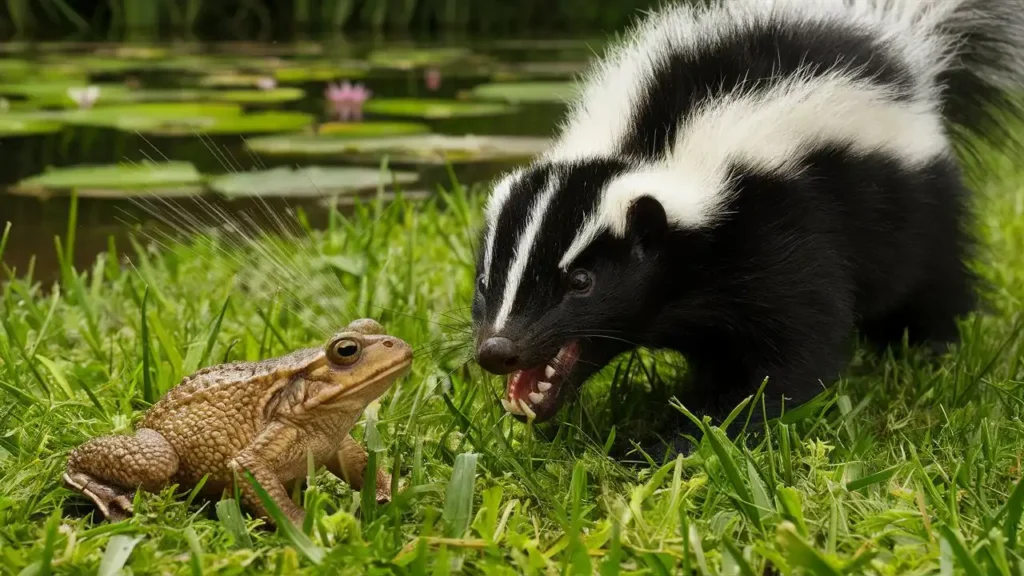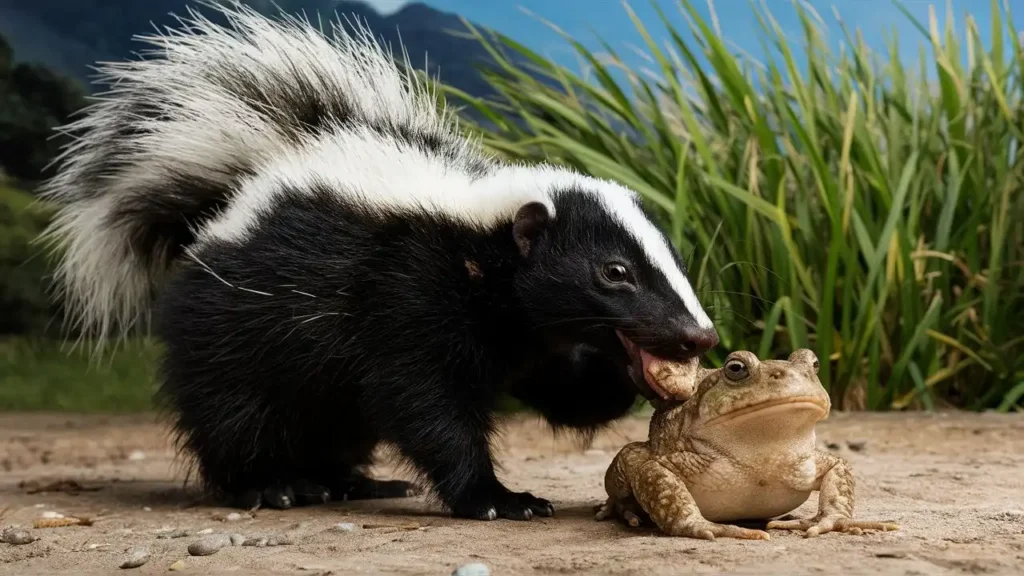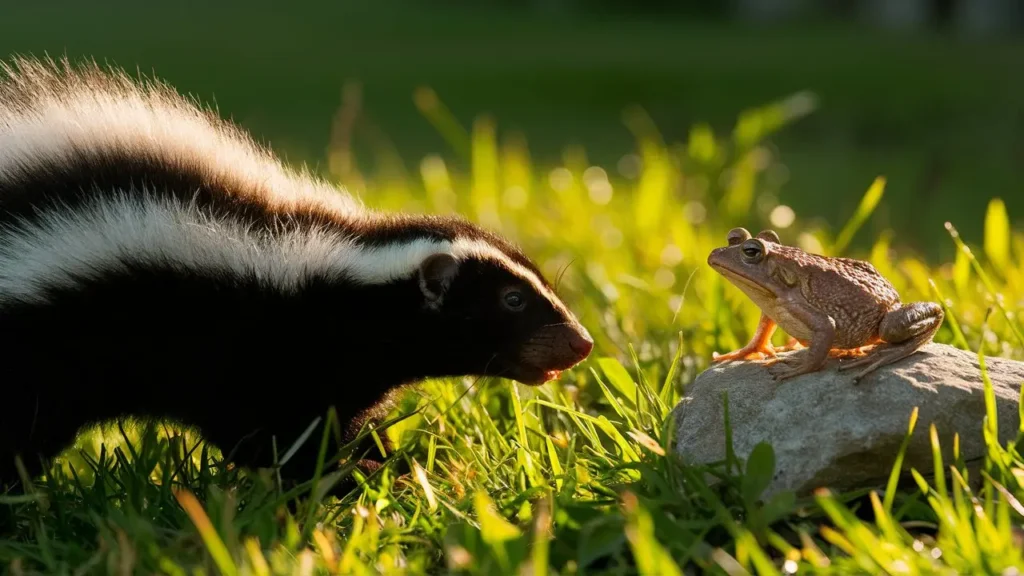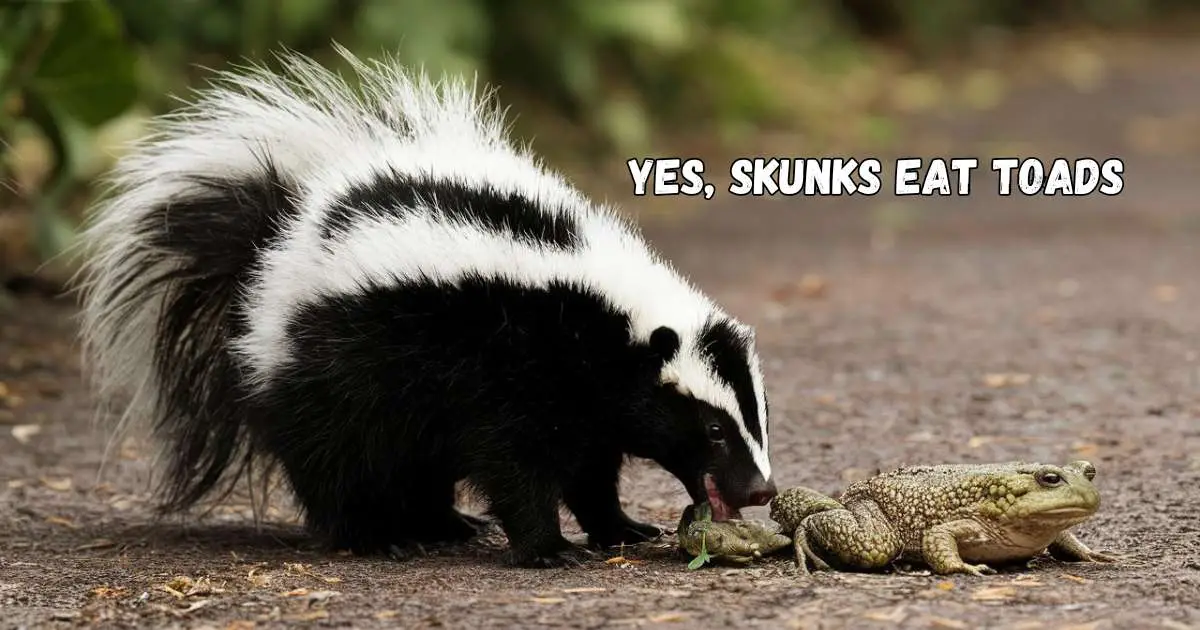Can Skunks Eat Toads?
Last updated on September 12th, 2024 at 11:16 pm
I’ve spent a lot of time observing my pet skunks and wild ones too, and here’s something cool I found out: skunks do eat toads! These clever animals have a mixed diet, snacking on everything from plants to insects to toads. The toads provide important nutrients for skunks, helping them stay healthy. If you’re interested in how skunks hunt and what else they eat, stick around!
Skunks’ Diet Composition
Skunks are fascinating creatures with interesting eating habits.
Understanding a skunk’s diet is crucial to grasping what these animals need to survive and how they impact their ecosystem.
Skunks are omnivores, meaning they eat both plants and animals.
Their diets vary widely depending on the season and what is available in their environment.
Typical Food Sources
Skunks have a broad diet that includes:
- Fruits and berries: A sweet part of their diet.
- Nuts and plants: They eat these to get nutrients.
- Small mammals: These provide protein for skunks.
- Eggs: They steal these from nests for a tasty snack.
Skunks use their sharp claws to dig for food hidden underground.
Insects And Amphibians As Prey
Skunks love to eat bugs and small amphibians. Let’s look at what they fancy:
- Insects: Beetles, larvae, and bees can be a meal.
- Amphibians: Frogs and toads are also on the menu.
While skunks do eat toads, they must be careful.
Some toads have toxic skin that can be harmful to skunks.
Still, skunks have adapted to handle small amounts of these toxins.
They are smart predators who know how to avoid danger
and find the best food to eat.
Toads As A Food Item
Skunks have a diverse diet, and toads are among the intriguing items they consume. Understanding the role of toads as a nutritious menu option for skunks provides insight into these creatures’ survival strategies.

Toad Hunting Behavior
Skunks are opportunistic foragers. They use their strong sense of smell to locate toads. Once a toad is found, they use their sharp claws to capture it. Toads employ defense mechanisms like puffing up their bodies and secreting toxins. Skunks, however, seem unaffected by toad toxins. They’ve adapted to handle these prey with ease.
Nutritional Value For Skunks
For skunks, toads are more than just a food source—they’re a packed source of nutrition. Toads provide protein and fat, which are essential for the skunk’s energy and health. By consuming toads, skunks maintain a balanced diet which is crucial for their survival in the wild.
The following table highlights the key nutritional components that skunks derive from eating toads:
| Nutritional Component | Benefit for Skunks |
|---|---|
| Protein | Muscle Growth and Repair |
| Fat | Energy Storage and Insulation |
| Minerals | Bone Health and Metabolic Processes |
At a closer look, the nutrient-rich nature of toads supports the skunk’s lifestyle. Skunks benefit greatly from incorporating these amphibians into their diet.
Natural Predatory Instincts
Wandering through gardens and forests at night, skunks reveal surprising eating habits. Not just scavengers, these black and white creatures are also predators. Among their prey, toads often become a target. Skunks’ natural predatory instincts drive them to hunt for a variety of food that ensures their survival.
Skunk Foraging Habits
Skunks boast a diverse menu when roaming the wild. What do these furry foragers fancy for dinner? Here’s a glimpse:
- Insects: Beetles, bees, and crickets
- Plants: Berries, leaves, and roots
- Small mammals: Mice and voles
- Bird eggs: A delicacy for the skunk
- Amphibians: Specifically, toads
With a keen sense of smell, skunks unearth their meals beneath soil and leaf litter.
Predation Techniques
Skunks employ patient and strategic hunting strategies. They capture toads with skill and ease. Here’s an outline of their technique:
- Sneak up: A silent approach is key
- Pin down: With sharp claws, they immobilize the toad
- Feast: The toad becomes a meal
Their methodical hunting ensures that skunks secure nourishment with minimal effort. Every hunt showcases the skunk’s innate predatory prowess. Even toads, with their defense mechanisms, aren’t safe from these savvy nocturnal hunters.
Toad’s Defense Mechanisms
Imagine you are a toad and a hungry skunk is near. What do you do? Toads have amazing ways to stay safe. Let’s explore how toads survive in the wild!

Toxic Secretions
Toads have a clever trick against predators like skunks. Their skin makes a special, icky liquid. This liquid can make animals sick. Skunks learn to leave toads alone because of this.
- Bitter taste: Stops animals from eating them.
- It makes animals poorly: Predators feel terrible if they try a toad.
- Strong smell: Warns predators to back off.
Camouflage And Escape
Toads also use hidden colors. They blend in with rocks and leaves. Skunks pass by without noticing them.
| Color | Hiding Spot |
|---|---|
| Brown or green | Forest floor |
| Bumpy skin | Looks like stones |
When hiding doesn’t work, toads leap away fast. Jumping skills save them from being dinner!
- Spot danger quickly.
- Jump to safety.
- Hide again in a new place.
The Ecosystem Impact
Imagine a garden at twilight, alive with different creatures. One surprising guest is the skunk, a creature many associate with their distinct smell. Yet, these mammals play a vital role in our ecosystem, known for their diverse diets, including insects, rodents, and sometimes, yes, toads. Understanding how the skunk’s diet influences the environment reveals the delicate balance of nature.
Food Chain Relevance
Skunks contribute significantly to the food chain. As omnivores, they control the population of various species, such as toads. Let’s use a bullet-point list to highlight how skunks maintain ecological balance:
- Regulating Prey Populations: By eating toads, skunks help prevent the overpopulation of these amphibians.
- Limited Competition: Feeding on diverse species reduces food competition among predators.
- Seed Dispersal: Skunks distribute plant seeds through their droppings, aiding plant diversity.
Biodiversity And Predator-prey Dynamics
Skunks play a part in preserving biodiversity. Their predation has direct effects on their prey, like toads, and indirect effects on the broader ecosystem. Here are some points that explain this role:
- Predator-Prey Relationships: The survival of skunks often relies on the availability of toads and other prey.
- Ecological Balance: Skunks help manage amphibian populations, ensuring no single species dominates.
- Ecosystem Health: A balanced predator-prey dynamic indicates a healthy ecosystem.
When the skunk’s prey numbers decrease, it impacts their diet and breeding habits. This in turn can shift the whole ecosystem. Therefore, protecting every species is crucial for our environment to thrive.
Skunks’ Habitat And Toad Availability
The curious case of skunks and their diet leads us down a path to their natural surroundings. To understand what skunks munch on, we peek into where they live and what’s on their dinner plate. Skunks are known for their distinctive black-and-white coloring, but their diet is just as interesting as their look. They are not fussy eaters, and toads happen to be among the many items they consume when available.

Territorial Range Overlap
Skunks make their homes in a variety of environments. Woods, grasslands, and even urban settings can all provide a cozy den for a skunk. This brings them into the same areas where toads are often found. Toads prefer moist, shaded areas such as under leaves or within dense grasses, making them accessible to foraging skunks. When skunks’ and toads’ living spaces cross paths, it’s likely that skunks will make a meal out of these amphibians.
Seasonal Diet Changes
With the shift of seasons, skunks adjust their diet. During spring and summer, insects and small critters, including toads, are in abundance. Skunks take advantage of this plentiful food source. Come fall, they shift to fruits and plants to store fat for the winter. While toads are more scarce when the weather cools, during the warmer months, these amphibians form a part of the skunk’s varied menu.
- Spring and Summer: Insects, toads, and small rodents.
- Fall: Fruits, nuts, and plants.
- Winter: The skunk’s diet depends on what is available; they may even dig into their fat reserves.
Human Observations And Research Findings
Skunks are known for their distinctive spray, but their diet often remains a mystery. Recent observations and research shed light on whether these nocturnal creatures prey on toads.
Documented Cases
Naturalists and wildlife enthusiasts have reported skunk activity around toad habitats. Intriguingly, some individuals have witnessed skunks feasting on toads firsthand.
- Video evidence from trail cameras
- Personal accounts from garden observations
- Journal entries by early naturalists
Wildlife Studies And Statistics
Studies focus on skunk diets and prey patterns. Researchers analyze stomach contents and scat to determine food preferences.
| Study | Location | % of Toads in Diet |
|---|---|---|
| Urban Skunk Diet Analysis | North America | 2% |
| Wild Skunk Feeding Habits | Europe | 3% |
Results vary depending on the environment and skunk species. The Spotted Skunk, for example, shows a higher tendency to consume toads.
Adapting Diets: Skunks In Urban Versus Wild Environments
When we think of skunks, we often picture their famous spray. But what about their eating habits? Especially the foods they find in different habitats. Wild skunks have a varied diet, including insects, small mammals, and yes, sometimes toads. But in urban spaces, skunks adapt to what’s available.
Urban Skunks’ Dietary Shifts
City life changes a skunk’s menu. With fewer natural resources, these adaptable creatures often turn to human waste. They rummage through trash and compost bins, searching for food. This transition from natural prey to human leftovers shows their incredible ability to adapt:
- Natural diet reductions: Fewer toads and insects due to urbanization.
- Trash as a food source: Accessible and plentiful in cities.
- Change in feeding patterns: Skunks may feed more at night in urban areas to avoid people.
Conservation And Wildlife Management
Understanding skunks’ dietary needs helps in their conservation. Urbanization can harm their traditional food sources. This affects their natural diet:
| Environment | Natural Diet | Urban Diet |
|---|---|---|
| Wild | Insects, rodents, toads | N/A |
| Urban | Reduced due to development | Trash, compost, pet food |
Educational programs can help people understand the impact of their waste on skunks’ eating habits. Conservation efforts aim to balance skunk populations with human activities:
- Trash management: Securing bins to restrict skunks’ access to garbage.
- Wildlife-friendly spaces: Creating green corridors in cities for natural food sources.
- Public awareness: Informing communities about skunks and cohabitation.
Frequently Asked Questions
What Do Skunks Like To Eat The Most?
Skunks primarily enjoy a diet rich in insects, grubs, and larvae. They also feast on small rodents, fruits, and plants.
What Is The Main Predator Of A Skunk?
The main predator of a skunk is the great horned owl, largely due to its weak sense of smell.
What Do Skunks Eat In My Yard?
Skunks in your yard typically feast on insects, grubs, small rodents, fruits, vegetables, and nuts. They may also dig for earthworms and larvae.
What Insects Do Skunks Eat?
Skunks predominantly feast on beetles, bees, grasshoppers, and crickets. They also consume larvae and other small insects as part of their diet.
Conclusion
Discovering whether skunks have a taste for toads can be surprising. Our journey through the diets of these curious mammals has revealed intriguing insights. Don’t forget, that while skunks might snack on toads occasionally, their eating habits are diverse. Keep exploring nature’s wonders for more fascinating creature behaviors!

